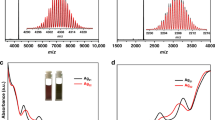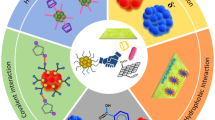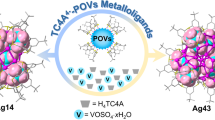Abstract
The surfaces of metal nanoclusters, including their interface with metal oxides, exhibit a high reactivity that is attractive for practical purposes. This high reactivity, however, has also hindered the synthesis of structurally well-defined hybrids of metal nanoclusters and metal oxides with exposed surfaces and/or interfaces. Here we report the sequential synthesis of structurally well-defined {Ag30} nanoclusters in the cavity of ring-shaped molecular metal oxides known as polyoxometalates. The {Ag30} nanoclusters possess exposed silver surfaces yet are stabilized both in solution and the solid state by the surrounding ring-shaped polyoxometalate species. The clusters underwent a redox-induced structural transformation without undesirable agglomeration or decomposition. Furthermore, {Ag30} nanoclusters showed high catalytic activity for the selective reduction of several organic functional groups using H2 under mild reaction conditions. We believe that these findings will serve for the discrete synthesis of surface-exposed metal nanoclusters stabilized by molecular metal oxides, which may in turn find applications in, for example, the fields of catalysis and energy conversion.

This is a preview of subscription content, access via your institution
Access options
Access Nature and 54 other Nature Portfolio journals
Get Nature+, our best-value online-access subscription
$29.99 / 30 days
cancel any time
Subscribe to this journal
Receive 12 print issues and online access
$259.00 per year
only $21.58 per issue
Buy this article
- Purchase on Springer Link
- Instant access to full article PDF
Prices may be subject to local taxes which are calculated during checkout




Similar content being viewed by others
Data availability
Crystallographic data for the structures reported in this Article have been deposited at the Cambridge Crystallographic Data Centre, under deposition numbers CCDC 2103710 (Ag16), 2103711 (Ag30) and 2103712 (Ag30′). Copies of the data can be obtained free of charge via https://www.ccdc.cam.ac.uk/structures/. All other spectroscopic and crystallographic data are included in the Supplementary Information. Source data are provided with this paper.
References
Jin, R., Zeng, C., Zhou, M. & Chen, Y. Atomically precise colloidal metal nanoclusters and nanoparticles: fundamentals and opportunities. Chem. Rev. 116, 10346–10413 (2016).
Chakraborty, I. & Pradeep, T. Atomically precise clusters of noble metals: emerging link between atoms and nanoparticles. Chem. Rev. 117, 8208–8271 (2017).
Luo, G.-G. et al. New protective ligands for atomically precise silver nanoclusters. Dalton Trans. 49, 5406–5415 (2020).
Yamamoto, K., Imaoka, T., Tanabe, M. & Kambe, T. New horizon of nanoparticle and cluster catalysis with dendrimers. Chem. Rev. 120, 1397–1437 (2019).
Takano, S. & Tsukuda, T. Chemically modified gold/silver superatoms as artificial elements at nanoscale: design principles and synthesis challenges. J. Am. Chem. Soc. 143, 1683–1698 (2021).
Du, Y., Sheng, H., Astruc, D. & Zhu, M. Atomically precise noble metal nanoclusters as efficient catalysts: a bridge between structure and properties. Chem. Rev. 120, 526–622 (2020).
Nie, X., Qian, H., Ge, Q., Xu, H. & Jin, R. CO oxidation catalyzed by oxide-supported Au25(SR)18 nanoclusters and identification of perimeter sites as active centers. ACS Nano 6, 6014–6022 (2012).
Li, G. & Jin, R. Gold nanocluster-catalyzed semihydrogenation: a unique activation pathway for terminal alkynes. J. Am. Chem. Soc. 136, 11347–11354 (2014).
Wang, S. et al. Total structure determination of surface doping [Ag46Au24(SR)32](BPh4)2 nanocluster and its structure-related catalytic property. Sci. Adv. 1, e1500441 (2015).
Yang, H. et al. Ligand-stabilized Au13Cux (x = 2, 4, 8) bimetallic nanoclusters: ligand engineering to control the exposure of metal sites. J. Am. Chem. Soc. 135, 9568–9571 (2013).
Yuan, S.-F., Lei, Z., Guan, Z.-J. & Wang, Q.-M. Atomically precise preorganization of open metal sites on gold nanoclusters with high catalytic performance. Angew. Chem. Int. Ed. 60, 5225–5229 (2021).
Dong, X.-Y., Gao, Z.-W., Yang, K.-F., Zhang, W.-Q. & Xu, L.-W. Nanosilver as a new generation of silver catalysts in organic transformations for efficient synthesis of fine chemicals. Catal. Sci. Technol. 5, 2554–2574 (2015).
Mitsudome, T. et al. Oxidant-free alcohol dehydrogenation using a reusable hydrotalcite-supported silver nanoparticle catalyst. Angew. Chem. Int. Ed. 47, 138–141 (2008).
Shimizu, K., Ohshima, K. & Satsuma, A. Direct dehydrogenative amide synthesis from alcohols and amines catalyzed by γ-alumina supported silver cluster. Chemistry 12, 9977–9980 (2009).
Desireddy, A. et al. Ultrastable silver nanoparticles. Nature 501, 399–402 (2013).
Yang, H. et al. All-thiol-stabilized Ag44 and Au12Ag32 nanoparticles with single-crystal structures. Nat. Commun. 4, 2422 (2013).
Sun, D., Luo, G.-G., Zhang, N., Huang, R.-B. & Zheng, L.-S. Simultaneous self-assembly of a cage-like silver(I) complex encapsulating an Ag6 neutral cluster core and carbon dioxide fixation. Chem. Commun. 47, 1461–1463 (2011).
Joshi, C. P., Bootharaju, M. S., Alhilaly, M. J. & Bakr, O. M. [Ag25(SR)18]−: the ‘golden’ silver nanoparticle. J. Am. Chem. Soc. 137, 11578–11581 (2015).
Dhayal, R. S. et al. [Ag21{S2P(OiPr)2}12]+: an eight-electron superatom. Angew. Chem. Int. Ed. 54, 3702–3706 (2015).
Qin, L. et al. Homoleptic alkynyl-protected Ag15 nanocluster with atomic precision: structural analysis and electrocatalytic performance toward CO2 reduction. Angew. Chem. Int. Ed. 60, 26136–26141 (2021).
Pope, M. T. Heteropoly and Isopoly Oxometalates (Springer, 1983).
Sadakane, M. & Steckhan, E. Electrochemical properties of polyoxometalates as electrocatalysts. Chem. Rev. 98, 219–238 (1998).
Lv, H. et al. Polyoxometalate water oxidation catalysts and the production of green fuel. Chem. Soc. Rev. 41, 7572–7589 (2012).
Miras, H. N., Yan, J., Long, D.-L. & Cronin, L. Engineering polyoxometalates with emergent properties. Chem. Soc. Rev. 41, 7403–7430 (2012).
Weinstock, I. A., Schreiber, R. E. & Neumann, R. Dioxygen in polyoxometalate mediated reactions. Chem. Rev. 118, 2680–2717 (2018).
Lechner, M., Güttel, R. & Streb, C. Challenges in polyoxometalate-mediated aerobic oxidation catalysis: catalyst development meets reactor design. Dalton Trans. 45, 16716–16726 (2016).
Izarova, N. V., Pope, M. T. & Kortz, U. Noble metals in polyoxometalates. Angew. Chem. Int. Ed. 51, 9492–9510 (2012).
Oms, O., Dolbecq, A. & Mialane, P. Diversity in structures and properties of 3d-incorporating polyoxotungstates. Chem. Soc. Rev. 41, 7497–7536 (2012).
Zheng, S.-T. & Yang, G.-Y. Recent advances in paramagnetic-TM-substituted polyoxometalates (TM = Mn, Fe, Co, Ni, Cu). Chem. Soc. Rev. 41, 7623–7646 (2012).
Suzuki, K. et al. Three-dimensional ordered arrays of 58 × 58 × 58 Å3 hollow frameworks in ionic crystals of M2Zn2-substituted polyoxometalates. Angew. Chem. Int. Ed. 51, 1597–1601 (2012).
Minato, T. et al. Robotic stepwise synthesis of hetero-multinuclear metal oxo clusters as single-molecule magnets. J. Am. Chem. Soc. 143, 12809–12816 (2021).
Wang, Y. & Weinstock, I. Polyoxometalate-decorated nanoparticles. Chem. Soc. Rev. 41, 7479–7496 (2012).
Xia, K., Yamaguchi, K. & Suzuki, K. Recent advances in hybrid materials of metal nanoparticles and polyoxometalates. Angew. Chem. Int. Ed. 62, e202214506 (2022).
Kikukawa, Y. et al. A discrete octahedrally shaped [Ag6]4+ cluster encapsulated within silicotungstate ligands. Chem. Commun. 49, 376–378 (2013).
Yonesato, K. et al. Controlled assembly synthesis of atomically precise ultrastable silver nanoclusters with polyoxometalates. J. Am. Chem. Soc. 141, 19550–19554 (2019).
Yonesato, K., Ito, H., Yokogawa, D., Yamaguchi, K. & Suzuki, K. An ultrastable, small {Ag7}5+ nanocluster within a triangular hollow polyoxometalate framework. Angew. Chem. Int. Ed. 59, 16361–16365 (2020).
Yonesato, K., Yamazoe, S., Yokogawa, D., Yamaguchi, K. & Suzuki, K. A molecular hybrid of an atomically precise silver nanocluster and polyoxometalates for H2 cleavage into protons and electrons. Angew. Chem. Int. Ed. 60, 16994–16998 (2021).
Contant, R. & Tézé, A. A new crown heteropolyanion K28Li5H7P8W48O184·92H2O: synthesis, structure, and properties. Inorg. Chem. 24, 4610–4614 (1985).
Mal, S. S. & Kortz, U. The wheel-shaped Cu20 tungstophosphate [Cu20Cl(OH)24(H2O)12(P8W48O184)]25− ion. Angew. Chem. Int. Ed. 44, 3777–3780 (2005).
Müller, A. et al. Metal-oxide-based nucleation process under confined conditions: two mixed-valence V6-type aggregates closing the W48 wheel-type cluster cavities. Angew. Chem. Int. Ed. 46, 4477–4480 (2007).
Pichon, C. et al. Characterization and electrochemical properties of molecular icosanuclear and bidimensional hexanuclear Cu(II) azido polyoxometalates. Inorg. Chem. 46, 5292–5301 (2007).
Mal, S. S. et al. Nucleation process in the cavity of a 48-tungstophosphate wheel resulting in a 16-metal-centre iron oxide nanocluster. Chemistry 14, 1186–1195 (2008).
Mitchell, S. G. et al. Face-directed self-assembly of an electronically active Archimedean polyoxometalate architecture. Nat. Chem. 2, 308–312 (2010).
Boyd, T. et al. POMzites: A family of zeolitic polyoxometalate frameworks from a minimal building block library. J. Am. Chem. Soc. 139, 5930–5938 (2017).
Yang, P., Alsufyani, M., Emwas, A.-H., Chen, C. & Khashab, N. M. Lewis acid guests in a {P8W48} archetypal polyoxotungstate host: enhanced proton conductivity via metal-oxo cluster within cluster assemblies. Angew. Chem. Int. Ed. 57, 13046–13051 (2018).
Sasaki, S., Yonesato, K., Mizuno, N., Yamaguchi, K. & Suzuki, K. Ring-shaped polyoxometalates possessing multiple 3d metal cation sites: [{M2(OH2)2}2{M(OH2)2}4P8W48O176(OCH3)8]16– (M = Mn, Co, Ni, Cu, Zn). Inorg. Chem. 58, 7722–7729 (2019).
Schön, G. et al. ESCA studies of Ag, Ag2O and AgO. Acta Chem. Scand. 27, 2623–2633 (1973).
Zhan, C.-H., Zheng, Q., Long, D.-L., Vilà-Nadal, L. & Cronin, L. Controlling the reactivity of the [P8W48O184]40− inorganic ring and its assembly into POMzite inorganic frameworks with silver ions. Angew. Chem. Int. Ed. 58, 17282–17286 (2019).
Chen, S., Fang, W.-H., Zhang, L. & Zhang, J. Atomically precise multimetallic semiconductive nanoclusters with optical limiting effects. Angew. Chem. Int. Ed. 57, 11252–11256 (2018).
Fan, X. et al. Threefold collaborative stabilization of Ag14-nanorods by hydrophobic Ti16-oxo clusters and alkynes: designable assembly and solid-state optical-limiting application. Angew. Chem. Int. Ed. 60, 12949–12954 (2021).
Asakura, H. et al. xTunes: a new XAS processing tool for detailed and on-the-fly analysis. Radiat. Phys. Chem. 175, 108270 (2020).
Ankudinov, A. L., Ravel, B., Rehr, J. J. & Conradson, S. D. Real-space multiple-scattering calculation and interpretation of X-ray-absorption near-edge structure. Phys. Rev. B 58, 7565–7576 (1998).
Acknowledgements
We gratefully acknowledge the financial support from JST PRESTO (JPMJPR18T7, JPMJPR19T9), JST FOREST (JPMJFR213M), JSPS KAKENHI (20H02749, 20H04659), and the JSPS Core-to-Core program, the Noguchi Institute and the Toray Science Foundation. Some of the computations were performed using the Research Center for Computational Science, Okazaki, Japan. XAFS measurements at SPring-8 were conducted with the approval of the Japan Synchrotron Radiation Research Institute (proposal numbers 2020A1219, 2021A1272, 2022A1627). Single-crystal X-ray diffraction measurements at SPring-8 were conducted with the approval of the Japan Synchrotron Radiation Research Institute (proposal numbers 2021A1034, 2022A1111, 2022B1605). We thank S. Kikkawa (Tokyo Metropolitan University) for help with XAFS measurements at SPring-8. We thank T. Kojima (Osaka University) for help with single-crystal X-ray diffraction measurements at SPring-8.
Author information
Authors and Affiliations
Contributions
K.S. conceived and designed the project. K.S. and K.Ya supervised the project. K.Yo. performed the major parts of synthesis and characterization of compounds. K.Yo. and T.K. performed crystallographic analysis. S.Y., K.Yo. and K.S. performed XAFS studies. D.Yo. and K.S. performed DFT studies. D.Ya. and K.S. performed catalytic studies.
Corresponding authors
Ethics declarations
Competing interests
The authors declare no competing interests.
Peer review
Peer review information
Nature Chemistry thanks Lei Zhang and the other, anonymous, reviewer(s) for their contribution to the peer review of this work.
Additional information
Publisher’s note Springer Nature remains neutral with regard to jurisdictional claims in published maps and institutional affiliations.
Supplementary information
Supplementary Information
Supplementary Tables 1–10, Figs. 1–26 and Notes 1–5.
Supplementary Data 1
Crystallographic data of Ag16.
Supplementary Data 2
Crystallographic data of Ag30.
Supplementary Data 3
Crystallographic data of Ag30′.
Supplementary Data 4
Source data for Supplementary Figs. 8 and 17, titration experiments.
Source data
Source Data Fig. 2
Observed and fitting data for XPS.
Source Data Fig. 3
Observed and fitting data for XPS.
Rights and permissions
Springer Nature or its licensor (e.g. a society or other partner) holds exclusive rights to this article under a publishing agreement with the author(s) or other rightsholder(s); author self-archiving of the accepted manuscript version of this article is solely governed by the terms of such publishing agreement and applicable law.
About this article
Cite this article
Yonesato, K., Yanai, D., Yamazoe, S. et al. Surface-exposed silver nanoclusters inside molecular metal oxide cavities. Nat. Chem. 15, 940–947 (2023). https://doi.org/10.1038/s41557-023-01234-w
Received:
Accepted:
Published:
Issue Date:
DOI: https://doi.org/10.1038/s41557-023-01234-w
This article is cited by
-
Ultra-stable and highly reactive colloidal gold nanoparticle catalysts protected using multi-dentate metal oxide nanoclusters
Nature Communications (2024)
-
Ag wrapped up
Nature Chemistry (2023)



